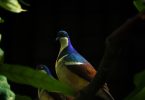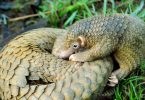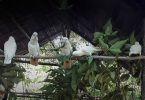The Philippines has one of the highest wild pig diversities in the world and the Visayan Warty Pig (Sus cebifrons) is one of the four species found only in the country. The other three are the Philippine Warty pig (Sus philippensis), the Palawan bearded pig (Sus ahoenobarbus), and the Mindoro warty pig (Sus oliveri). Another wild pig species, the Bornean bearded pig (Sus barbatus), is also found in Sulu, Tawi-Tawi and other nearby islands in Southeast Asia.
The Visayan Warty Pig has several local names such as Baboy Ilahas which means ‘wild pig’ in Cebuano, Hiligaynon, and Waray. The Visayas Region, like in all parts of the Philippines, has different languages so this wild pig has been called differently depending on its location. Other names include Baboy Ramo (wild boar) in Waray, Baboy Talonon (forest pig) in Hiligaynon and Baboy Sulop (dark pig) in Cebuano.
The male is known for growing crests and manes during breeding season. When excited or threatened, it raises its spiky mane. It is called the Visayan Warty Pig because the males have three pairs of warts on their faces which are thought to provide protection from the tusks of their rivals. Both male and female have this white line of fur across their snout. They stand at about 2 to 3 feet tall and males are much larger than females. They can live for up to 15 years.
The females are pregnant for about four months and then give birth to up to four piglets. The white-striped piglets become independent at around six months. The pigs live in groups composed of one adult male, several females and their young. An adult male without a sounder can live on its own or form a bachelor group. They forage during dawn, dusk or night while spending the day mostly in mud baths.
The pig is omnivorous and its favorite food include fruits, roots, tubers or bulbs. It can locate its food even for several feet under the ground because of its very keen sense of smell!
Visayan Warty Pig is Critically Endangered
Dense and tropical rainforests are its natural habitat. It is native to the islands of Cebu, Guimaras, Masbate, Negros, Panay and Siquijor. It is critically endangered and believed to be extinct in these islands except for Negros and Panay. Habitat loss due to deforestation and hunting are the main factors for the decline of its population. The pig is also being bred with domestic pigs which further threaten its number. There are rescue and breeding centers established by the Philippine government to help preserve the Visayan Warty Pig. Learn how to help the Visayan Warty Pig by visiting organizations like the Talarak Foundation which help protect the Visayan Wildlife.
The Philippines is rich in natural wonders including its wildlife. There are many of these that are unique only to this country and most of their population are threatened. Make your visit to the Philippines more fun by knowing and helping this threatened species!
Photo Gallery
Additional Information
Check out the links below to learn more about the Visayan Warty Pig and animals native to the Philippines.







